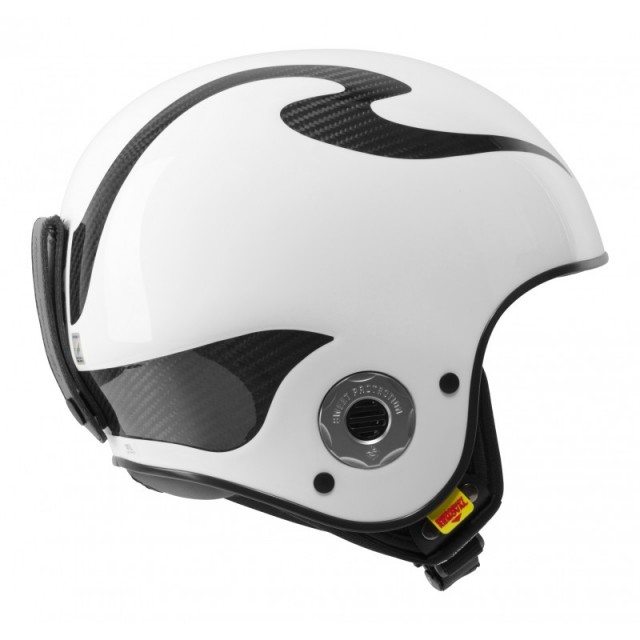These days, most people understand that when we’re out skiing, biking, boating, or climbing, it’s pretty stupid not to wear a helmet. More than ever before, we are gaining a better understanding of the variety and the devastating consequences of head injuries, ranging from (what we used to call) “mild” concussions, to full-blown “CTE” (Chronic Traumatic Encephalopathy).
But while we can agree that helmets are a good idea, it is pretty alarming how little most of us know beyond that — and that lack of knowledge could prove to be dangerous.
Are all helmets pretty much the same, and equally safe? What’s up with all those different safety certifications? What should a helmet fit like if it is actually going to protect your head? What are the main things you should you be looking for, and what do you most need to know, before selecting and purchasing a helmet? One thing’s for sure: the time to figure all of this out is not after you’ve had a bad crash.
In this episode, we talk to Ståle Møller, the lead designer and co-founder of Sweet Protection.

We talked to Ståle for a very long time at SIA this past year, and we came away so impressed that Ståle earned our ‘favorite person we talked to at SIA’ award.
Ståle has spent a lot of his time thinking about and designing helmets, and I am confident of three things if you listen to this podcast: (1) You will come away much better informed about how to protect your head; (2) You will almost certainly purchase helmets differently in the future, and (3) You will see why we were so impressed with Ståle back at SIA.
[powerpress]
Topics and Times:
• What is your background — athletic and academic?
• How did you get into helmet design (4:15)
• How did you go from making some products to starting a company, Sweet Protection (12:20)
• What are the most important factors for people to consider when purchasing a helmet? (17:20)
• What does a “properly sized” helmet fit like / feel like? (19:00)
• What is the real difference — in terms of safety — between a $80 helmet and a $300 helmet? (26:30)
• Does “MIPS” (Multidirectional Impact Protection System) matter? (30:25)
• What’s up with “Multi-Impact” helmets? (35:58)
• How do I evaluate / know when it’s time to replace my helmet? (41:04)
• What are the trickiest compromises to deal with in helmet design? (43:13)
• Why use carbon fiber in helmets? Is it just for the bling factor? (53:00)
• What’s next for Sweet Protection — are there other categories Sweet is looking to move into? (1:07:42)
• As a designer of helmets for outdoors sports, what other fields are you paying attention to? (1:09:00)
• Where are we in terms of helmet tech — pretty advanced, or in the early stages of development? (1:14:20)
• How do helmet certifications differ? Is one better than the others? Are they the same for bike and ski? (1:18:41)
• What makes Sweet Protection’s price-point helmets different or better than others on the market? And why should someone consider buying a kid’s helmet from Sweet? (1:25:50)
• What makes Sweet’s top-of-the-line helmets different or better than others on the market? (1:29:40)
Show Notes:
• Sweet Protection’s Most Advanced Ski Helmet — the Rooster Discesa RS Helmet:
• Watch the Rooster Discesa RS get assembled for Aksel Lund Svindal
• Learn more about MIPS Technology at the MIPS website
Episode Sponsor: Nest Bedding (nestbedding.com)
It’s easy to forget this, but proper sleep is one of the most important elements of peak performance. And it’s no coincidence that many top athletes are sleeping great on the comfortable beds from Nest Bedding. (Get on Twitter, and You’ll find Ayesha Curry reporting that the Currys are loving their Alexander Hybrid mattress from Nest.)
So If you’d like to perform better and feel better every single day, then go to nestbedding.com — the affordable alternative to overpriced mattress stores — to see which of their mattresses is the best option for you.
And since we have a thing for honest reviews around here, check out the hundreds and hundreds of customer reviews from verified Nest Bedding buyers — you’ll see that Nest Bedding has earned its reputation for quality and customer service.


I have a long, skinny head. I wear a high-end giro now, but it has never felt good on my head. I would say ‘good enough’. But then again, I haven’t yet found a helmet that does. I actually melt the foam in front of my helmet to give my head more room. I could go to a larger helmet, but then I have too much space on the sides. I wish buying guides (hint, hint) gave some guidance to head shape. Smith’s seems suited to round heads. Great helmets, but they never fit me. But who knows, there are so many helmets within a brand. Giro has twenty different helmets, and equipment stores will only have a portion of those helmets available to try on. When I go to a ski shop, I don’t look at skis. I typically go to the helmet section first and try on lids in hopes that I have that “a ha” moment. So far, no luck. Have you ever heard of helmet fitters? Anywhere? I want to say that’s kind of kooky, but comfort is worth paying for.